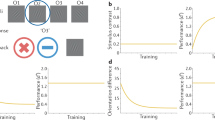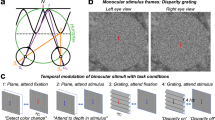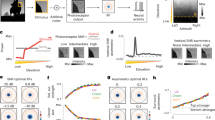Abstract
WHEN confronted with Julesz random-dot stereograms1 for the first time, naive observers often need as long as a minute or more to see a global figure in depth. With repeated exposure to the stereograms this perception time is progressively reduced until they begin to see depth almost instantaneously2. This acceleration of the stereoscopic process over successive trials is a remarkable example of perceptual learning2,3, and unlike many other kinds of perceptual learning it seems to be a purely visual effect. Further, stereopsis is a basic visual function for which much of the processing may occur as early as the prestriate cortex4. It is important to note that learning-like changes can affect such a process, and knowledge of elementary visual function may be helpful in determining just what is learned. Here I explore the position specificity of stereo-learning, and find that in most observers a significant proportion of the learning that is acquired in one retinal area does not transfer to neighbouring areas. One question raised by this finding is whether such position specificity necessarily implies localisation of the learning process to specific anatomical areas in the brain.
This is a preview of subscription content, access via your institution
Access options
Subscribe to this journal
Receive 51 print issues and online access
$199.00 per year
only $3.90 per issue
Buy this article
- Purchase on Springer Link
- Instant access to full article PDF
Prices may be subject to local taxes which are calculated during checkout
Similar content being viewed by others
References
Julesz, B., Bell. Syst. Tech., J 39, 1125 (1960).
Ramachandran, V. S., and Braddick, O., Perception, 2, 371 (1973).
Sekuler, R., A. Rev. Psychol., 25, 196 (1974).
Hubel, D. H., and Wiesel, T. N., Nature, 225, 41–2 (1970).
Julesz, B., Foundations of Cyclopean Perception (University of Chicago Press, 1971).
Hebb, D. O., Organisation of Behaviour (Wiley, New York, 1949).
Sutherland, N. S., Proc. R. Soc., B 171, 297–317 (1968).
Neisser, U., Cognitive psychology (Appleton-Century-Crofts, New York, 1967).
Pribram, K. H., Languages of the Brain, 140–166 (Prentice-Hall, Eaglewood Cliffs, New Jersey, 1971).
Wallach, H., and Austin, P., Am. J. Psychol., 67, 338–340 (1954).
Author information
Authors and Affiliations
Rights and permissions
About this article
Cite this article
RAMACHANDRAN, V. Learning-like phenomena in stereopsis. Nature 262, 382–384 (1976). https://doi.org/10.1038/262382a0
Received:
Accepted:
Published:
Issue Date:
DOI: https://doi.org/10.1038/262382a0
This article is cited by
-
Perceptual learning of line orientation modifies the effects of transcranial magnetic stimulation of visual cortex
Experimental Brain Research (2005)
-
Visual pattern recognition in Drosophila involves retinotopic matching
Nature (1993)
Comments
By submitting a comment you agree to abide by our Terms and Community Guidelines. If you find something abusive or that does not comply with our terms or guidelines please flag it as inappropriate.



